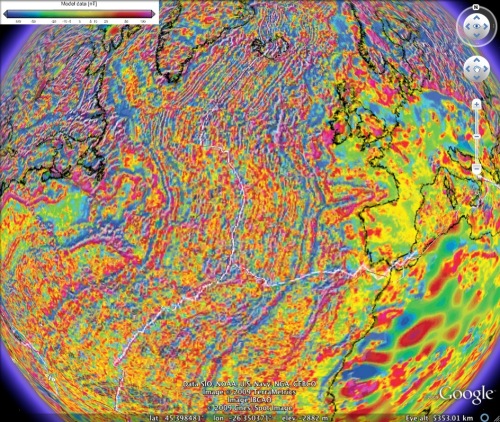 On the 6th day of Christmas my true love sent to me: 6 fields a-flipping
On the 6th day of Christmas my true love sent to me: 6 fields a-flipping
About every millon years or so, on average, the Earth’s magnetic field reverses itself: the north magnetic pole becomes the south magnetic pole, and vice versa. The most visible evidence for this can be found in the world’s ocean basins, where the striped magnetic anomalies that provided compelling evidence for sea-floor spreading and mid-ocean ridges also provide a continuous history of the last 200 million years of so of geomagnetic field behaviour.

Magnetic anomalies in the North Atlantic. Source: SDSU (link to kml file)
As I have explained before, ‘on average’ has no real predictive power: the field can spend only a few hundred thousand years in one polarity state before switching to the other, then right afterwards spend a few million years in that state before flipping again. At least as far as we can tell, there is no periodicity to field reversals. This very unpredictability does have a rather useful consequence, however. Because, at least as far as we know, there is no real periodicity to the field, over any particular period the temporal pattern of magnetic field reversals – how often the field reverses, and when – is unique to that period, and unlike the pattern in any other period. So if, for example, I am trying to date a sedimentary sequence that spans six magnetic polarity reversals, with mostly normal (shaded black) periods, or chrons, interspersed with shorter reversed (white) chrons:

from the temporal pattern of reversals – at least a medium normal, very short reversed, longish normal, medium reversed, medium normal, short reversed, at least a long normal – I can fairly confidently match it to the series of reversals that occurs over the KT boundary. As long as your sequence spans enough polarity chrons, that pattern is not going to be like any over period covered by the geomagnetic polarity timescale (GPTS) principally constructed from measurement and dating of the seafloor magnetic anomalies.

This is effectively what magnetostratigraphy is all about: locating polarity reversals within a sequence and matching the pattern of polarity reversals to the existing. Reversals are extremely good chronological markers: they are usually well-dated, occur virtually instantaneously from a geological perspective (a few thousand years is not very significant if you’re looking at a sequence spanning a few million) and, most importantly, mark a global event that is simultaneously recorded by rocks forming in all sorts of ways and environments. Magnetostratigraphy is therefore especially good for long distance correlations between sequences that record environments so different from each other that the same index fossils may not be present in them.
The sequence of seafloor magnetic anomalies is often described as a magnetic barcode, and in a very real sense it can act as one: with the right palaeomagnetic tools, you can read the age of a geological section directly from the recorded sequence of reversals.



Comments (5)